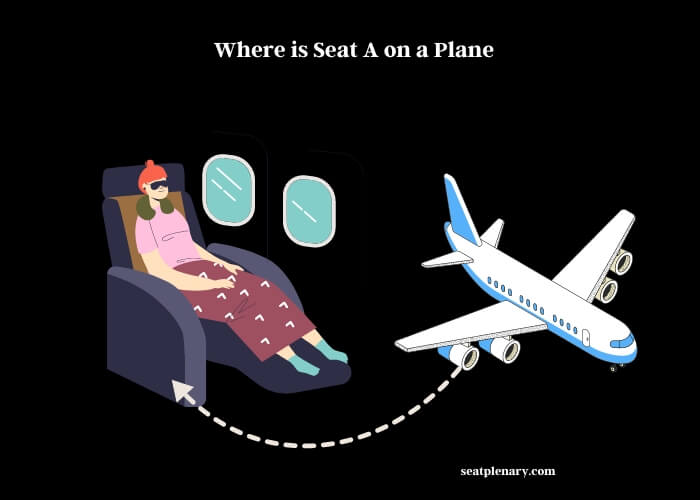The location of seat “A” on a plane typically falls on the far left side of the aircraft’s seating configuration. It’s normally the seat closest to the window, providing a panoramic view of the skies. The allocation of letters is dependent on the specific plane’s width, meaning the seat mapping can change from one aircraft to another.
In most common airplane models, seat “B” tends to be next to “A,” located on the left side but closer to the aisle. On the other hand, seat “C” usually shifts to the right side of the plane, especially in aircraft with a three-seat configuration on either side of the aisle.

Just like seat “C,” seat “D” is also generally found on the right side of the plane. However, in larger aircraft with two aisles, seat “D” might fall in the center cluster of seats. The letters “E” and “F” follow suit, with “E” often nestled between “D” and “F,” while “F” is frequently an aisle seat on the right-hand side in single-aisle planes.
Different planes adopt various seat numbers and letters systems. This seating nomenclature varies based on the model and make of the aircraft. Therefore, to find your seat on a plane, it’s critical to refer to the specific airline’s seating chart. These charts are typically available online or at the airport.
“A” is usually a window seat on the left side of the plane, and each subsequent letter corresponds to the next seat in the row. As we move from “A” to “F,” we generally traverse from the left-hand window, across the aisle, to the right-hand side of the plane.
The Blueprint of Airplane Seating Arrangement
Airplane seating arrangements or seat maps serve as a vital guide for passengers during their travels. These seat maps reveal the exact positioning of seats, which are typically labeled with letters and numbers. The letters represent columns, while the numbers indicate rows. For instance, “A3” would refer to the third row in the “A” column.
It’s worth noting that not all aircraft are alike. Layouts can vary significantly based on the airline and the specific model of the aircraft. For instance, a single-aisle airplane like a Boeing 737 will have a different layout compared to a double-aisle Airbus A380. It’s always beneficial to review the seating layout of your specific aircraft before traveling.
Reading Your Boarding Pass: Key Information
Your boarding pass carries more than just your name. It’s also home to valuable information like your seat number, which includes the column letter and row number. The details on your boarding pass direct you to your exact seat on the aircraft, minimizing confusion and making the boarding process smoother.
In terms of navigation, simply follow the seat map displayed in the aircraft, which is typically situated above the overhead bins. The map will guide you to your seat using the row number and the column letter.
Seat A: A Visual Journey
The “A” seat generally has a specific location on aircraft. In a single-aisle aircraft with a 3-3 layout (three seats on either side of the aisle), Seat A is usually the window seat on the left when facing forward. In a double-aisle airplane, Seat A’s location can change depending on the specific layout of the aircraft.
The placement of Seat A can also depend on other factors, such as the aircraft model, the airline’s preferences, and the type of flight (short-haul or long-haul). It’s always best to review the seat map of your specific flight to ascertain the exact location of Seat A.
Analyzing the Pros and Cons of Seat A
Seat A, typically a window seat, presents unique advantages and potential disadvantages. On the one hand, it offers a fantastic view, especially for those who enjoy gazing at the clouds or the landscape below. The window position also allows for a bit of extra room, making the space feel less confined.
On the other hand, Seat A can pose some challenges. The window position can make exiting the row a bit tricky, especially if the other seats in the row are occupied. Those who frequently use the lavatory or prefer to stretch their legs on long flights might find this location inconvenient.
Seat A in Different Flight Types: Short-haul vs Long-haul
Seat A can offer varying experiences depending on the duration of your flight. On short-haul flights, the view and extra space offered by Seat A can significantly enhance the travel experience, while the limitations regarding movement are less likely to pose a problem due to the shorter flight duration.
For long-haul flights, while the benefits of the view and extra space remain, the drawbacks may become more apparent. Limited mobility over a long period could lead to discomfort, particularly for passengers who like to move around during the flight.
An In-depth Analysis of Seat A across Popular Aircraft Models
The location and features of Seat A can differ across aircraft models. Here are some specifics for popular models:
Seat A on the Boeing 737: On the Boeing 737, a single-aisle aircraft, Seat A is typically the window seat on the left-hand side of the plane when facing forward. It provides a great view and a slight bit more of personal space due to its positioning.
Seat A on the Airbus A320: Like the Boeing 737, the Airbus A320 is a single-aisle aircraft. Seat A is usually located in a similar spot – the window seat on the left-hand side when facing forward.
Seat A on the Boeing 777: The Boeing 777 is a wide-body, twin-aisle aircraft. The placement of Seat A can differ based on the specific seating arrangement. It is usually found as a window seat on the left-hand side of the plane, offering ample personal space and great views.
Seat A on the Airbus A380: The Airbus A380, a large double-deck, four-engine jet, has a more complex layout. Seat A is usually located on the left-hand side on both decks, offering the advantage of window views.
Comparing Seat A Across Various Aircraft Models
| Aircraft Model | Comfort Factor | Accessibility | View |
| Boeing 737 | High | Moderate | Excellent |
| Airbus A320 | High | Moderate | Excellent |
| Boeing 777 | Very High | Moderate | Excellent |
| Airbus A380 | Very High | Moderate | Excellent |
Selecting the Right Seat for Your Journey: Factors to Consider
Selecting the best seat for your flight can hinge on many considerations. Beyond Seat A, passengers need to evaluate factors like legroom, proximity to lavatories and galleys, and the view from the window. Online tools such as SeatGuru can help you check the seat map for your specific flight and read reviews from other passengers about individual seats.
First-Hand Experiences: Travels from Seat A
Seat A stories can provide valuable insights from those who have experienced this seat first-hand. Many travelers favor Seat A for the unmatched views it offers, particularly during takeoff and landing. The extra bit of personal space is also commonly appreciated.

Despite its advantages, some passengers note that being in Seat A can make it a bit difficult to move out of the row, especially if the adjacent seats are occupied. Frequent travelers recommend considering your personal preferences and flight habits before choosing Seat A.
Pros and Cons of Seat A on Popular Airlines
| Airline | Pros of Seat A | Cons of Seat A |
| Airline 1 | Excellent view, more personal space | Limited mobility |
| Airline 2 | Excellent view, more personal space | Limited mobility |
| Airline 3 | Excellent view, more personal space | Limited mobility |
| Airline 4 | Excellent view, more personal space | Limited mobility |
FAQs
How Can I Find My Seat Number on a Plane?
Your seat number is typically indicated on your boarding pass. It usually includes a letter and a number, representing the column and row of your seat on the airplane, respectively. For instance, “A3” would point to the third row in the “A” column.
Which Seat Is A on a Plane?
In most airplane layouts, Seat A is usually the window seat on the left-hand side of the plane when facing forward. However, the exact position can vary depending on the aircraft model and the airline’s specific seating arrangement.
Why Does Seat A Often Represent the Window Seat?
Seat A often represents the window seat due to common aircraft seat labeling systems, which usually start with the letter “A” for the first column on the left (when facing forward). As window seats are generally on the edges of the seating layout, they are often designated as Seats A.
Can Seat A Vary in Position across Different Aircraft Models?
Yes, the position of Seat A can vary across different aircraft models. While it’s typically the window seat on the left-hand side in single-aisle aircraft, its position could differ in wide-body or double-aisle aircraft depending on the specific seating arrangement.
What Is Seat H on a Plane?
The position of Seat H can depend on the airplane’s specific layout. In a double-aisle airplane, for instance, Seat H might be a window seat on the right side of the plane or a middle seat, depending on the configuration. It’s best to check the specific seating chart for your flight.
Are All Window Seats Designated as Seat A?
No, not all window seats are designated as Seat A. While Seat A often represents a window seat, other letters can also denote window seats, particularly in larger aircraft with multiple columns of seats. For instance, in an aircraft with a three-three layout (three seats on each side of the aisle), the window seats could be Seats A and F.
Where Is Seat B on a Plane?
Seat B is typically next to Seat A in the seating layout of an airplane. In a single-aisle airplane with a typical three-three configuration, Seat B is usually the middle seat on the left side of the plane, next to the window seat A.
Read more:
